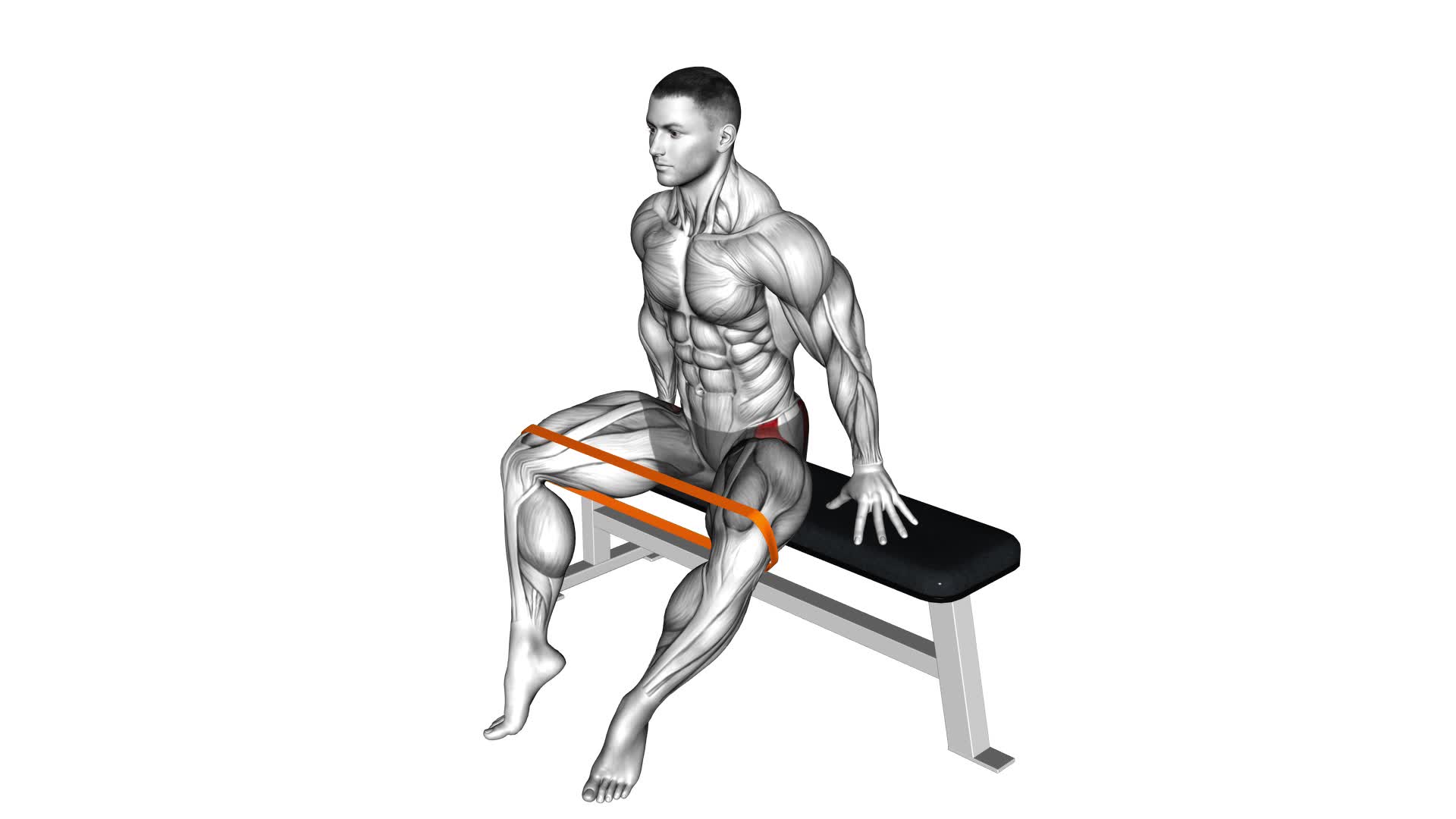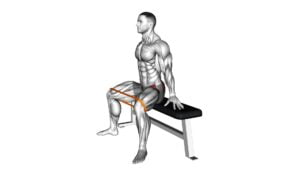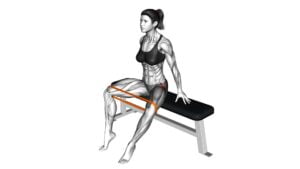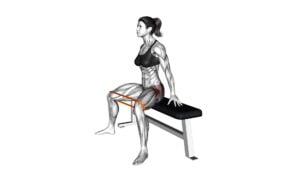Resistance Band Seated Hip Abduction – Video Exercise Guide & Tips

Looking to strengthen your hips and improve your overall lower body strength? Look no further than the resistance band seated hip abduction exercise.
Watch This Exercise Video
In this video exercise guide, we'll show you step-by-step how to properly perform this exercise using a resistance band. Whether you're a beginner or an experienced fitness enthusiast, we'll also provide variations and modifications to suit your fitness level.
Get ready to feel the burn and maximize your results with this effective exercise.
Key Takeaways
- Resistance band seated hip abduction increases hip strength and stability.
- It targets the gluteus medius, gluteus minimus, and tensor fasciae latae muscles.
- The exercise improves balance and prevents injuries.
- Proper form and gradually increasing resistance are important for maximizing results and preventing injury.
Benefits of Resistance Band Seated Hip Abduction
You'll experience increased hip strength and stability with resistance band seated hip abduction. This exercise is highly effective in activating the muscles of your hip, helping you to strengthen and tone them. The resistance band adds an extra challenge, forcing your muscles to work harder and enhancing their activation. By performing seated hip abduction with a resistance band, you can target the gluteus medius, gluteus minimus, and tensor fasciae latae muscles, which play a crucial role in hip stability and balance.
The resistance band seated hip abduction exercise is particularly beneficial for improving balance. The muscles targeted in this exercise are responsible for stabilizing your pelvis and maintaining proper alignment during movements. Strengthening these muscles can help prevent injuries, especially for activities that require balance and stability, such as walking, running, and playing sports. Additionally, by enhancing muscle activation in the hip area, this exercise can also contribute to better overall body coordination and control.
To maximize the benefits of resistance band seated hip abduction, it's important to perform the exercise correctly. Start by sitting on a chair or bench with your back straight and feet flat on the ground. Place the resistance band around your thighs, just above your knees. Slowly lift one leg out to the side, keeping it straight and maintaining tension in the band. Pause briefly at the top before lowering your leg back down. Repeat on the other side. Aim for 10-15 repetitions on each leg, gradually increasing the resistance as you become stronger.
Equipment Needed for the Exercise
To perform resistance band seated hip abduction, you'll need a few pieces of equipment. Here are the items you need to gather before starting your hip strengthening exercise:
- Resistance band: Choose a resistance band that suits your fitness level. Make sure it's long enough to comfortably wrap around your thighs while seated.
- Chair: Find a stable chair with a straight back. Make sure it's strong enough to support your weight throughout the exercise.
- Mat: Place a mat or a towel on the chair seat to provide cushioning and prevent discomfort.
- Timer or Clock: Use a timer or a clock to keep track of your exercise duration. This will help you maintain consistency and progress over time.
Having the right equipment is essential for performing resistance band exercises effectively.
Now that you have gathered all the necessary items, you're ready to move on to the next section, which will guide you through the step-by-step process of executing the resistance band seated hip abduction exercise with proper form.
Step-by-Step Guide for Proper Form
Now, let's dive into how to perform the resistance band seated hip abduction exercise with proper form.
To begin, sit on a chair or bench with your back straight and feet flat on the floor. Place a resistance band around both of your legs, just above the knees.
To perform the exercise, start by slowly pushing your legs apart, against the resistance of the band. Keep your knees and toes facing forward throughout the movement. Make sure to engage your hip muscles as you push outward, feeling the tension in your outer thighs.
It's important to maintain control and avoid using momentum to perform the exercise. Keep the movement slow and controlled, focusing on the contraction of your hip muscles.
Common mistakes to avoid include allowing your knees to cave in or your back to round. Keep your knees in line with your toes and maintain proper posture throughout the exercise.
If you don't have a resistance band, there are alternative exercises you can try. Side-lying leg lifts or clamshells are effective options that target the same muscles.
Remember to always consult with a professional before starting any new exercise routine, and listen to your body to avoid injury.
Variations and Modifications for Different Fitness Levels
To accommodate different fitness levels, there are various variations and modifications you can incorporate into the resistance band seated hip abduction exercise. These modifications allow you to tailor the exercise to your specific needs and goals. Here are four different exercises that can help you progress at your own pace:
- Resistance Band Seated Hip Abduction with Light Band: If you're a beginner or have limited hip strength, start with a light resistance band. Loop the band around your thighs just above your knees and perform the exercise as demonstrated in the video guide.
- Resistance Band Seated Hip Abduction with Medium Band: Once you feel comfortable with the light band, you can progress to a medium band for added resistance. This will challenge your hip muscles even more and help you build strength.
- Resistance Band Seated Hip Abduction with Heavy Band: For individuals with advanced fitness levels or those looking for an extra challenge, a heavy resistance band can be used. The increased tension will engage your hip muscles to a greater extent and promote further progression.
- Resistance Band Seated Hip Abduction with Ankle Weights: To further intensify the exercise, you can incorporate ankle weights. This will add extra resistance and increase the workload on your hip abductor muscles.
Remember to always listen to your body and choose the modification that best suits your fitness level. Progress gradually and aim to challenge yourself without compromising your form or risking injury.
Tips to Maximize Results and Prevent Injury
For maximum results and injury prevention, it's important to implement these tips into your resistance band seated hip abduction routine. To prevent common mistakes and ensure effective incorporation of resistance bands, follow these guidelines.
Firstly, choose the right resistance band for your fitness level. Bands come in different levels of resistance, so select one that challenges you without causing strain or discomfort.
Secondly, maintain proper form throughout the exercise. Sit with your back straight and shoulders relaxed. Keep your feet flat on the floor and your knees bent at a 90-degree angle. Engage your core muscles and avoid leaning or twisting your body.
Next, start with a lighter resistance band and gradually increase the tension as your strength improves. This gradual progression will help prevent injuries and allow your muscles to adapt to the resistance.
Additionally, avoid jerking or using momentum to perform the exercise. Move slowly and smoothly, focusing on contracting your hip muscles. This controlled movement will target the correct muscle groups and maximize the effectiveness of the exercise.
Finally, listen to your body and stop if you experience any pain or discomfort. Remember to warm up before starting your routine and stretch afterwards to prevent muscle tightness and soreness.
Frequently Asked Questions
How Many Repetitions Should I Aim for When Performing Resistance Band Seated Hip Abduction?
When performing resistance band seated hip abduction, you should aim for a number of repetitions that challenges your hip muscles but allows you to maintain proper form. The exact number of repetitions may vary depending on your fitness level and goals. However, a good starting point is to aim for 10 to 15 repetitions per set.
As you progress and improve hip strength, you can increase the number of repetitions or explore variations of seated hip abduction exercises for added challenge and variety.
Can Resistance Band Seated Hip Abduction Help With Improving Balance and Stability?
Resistance band seated hip abduction is a great exercise for improving balance and stability. By targeting the hip muscles, it helps to strengthen the muscles responsible for stabilizing your pelvis and lower body. This exercise also activates the core muscles, which further enhances stability.
To progress the difficulty and challenge your balance even more, you can increase the tension of the resistance band or perform the exercise on an unstable surface like a balance board.
Are There Any Specific Muscles Targeted During Resistance Band Seated Hip Abduction?
During resistance band seated hip abduction, specific muscles are targeted to strengthen and tone your hips and glutes. This exercise primarily works the gluteus medius and minimus, which are important for hip stability and balance. By engaging these muscles, you can improve your athletic performance and prevent injuries.
Resistance band seated hip abduction is a great addition to any workout routine, providing targeted benefits for athletes looking to enhance their lower body strength and stability.
Is It Safe to Perform Resistance Band Seated Hip Abduction if I Have a Hip Injury or Condition?
If you have a hip injury or condition, it's important to take precautions when performing resistance band seated hip abduction.
Consult with your healthcare provider or a qualified fitness professional before attempting this exercise. They can provide guidance on whether it's safe for you and suggest alternative exercises for hip abduction that may be more suitable for your condition.
Your safety and proper recovery should always be the top priority.
How Often Should I Include Resistance Band Seated Hip Abduction in My Workout Routine for Optimal Results?
To achieve the best results, it's important to consider how frequently you should include resistance band seated hip abduction in your workout routine.
By incorporating this exercise regularly, you can optimize your results and strengthen your hip muscles effectively.
However, it's crucial to listen to your body and not overdo it.
Consulting with a healthcare professional or a certified trainer can help you determine the appropriate frequency for your specific needs and goals.
Conclusion
In conclusion, the resistance band seated hip abduction exercise is a highly beneficial workout for strengthening the muscles in your hips and thighs.
By following the step-by-step guide and using the proper form, you can maximize your results and prevent injuries.
Remember to start with the appropriate resistance level and gradually increase it as you get stronger.
With consistent practice, this exercise can help improve your hip stability and overall lower body strength.

Author
Years ago, the spark of my life’s passion ignited in my mind the moment I stepped into the local gym for the first time. The inaugural bead of perspiration, the initial endeavor, the very first surge of endorphins, and a sense of pride that washed over me post-workout marked the beginning of my deep-seated interest in strength sports, fitness, and sports nutrition. This very curiosity blossomed rapidly into a profound fascination, propelling me to earn a Master’s degree in Physical Education from the Academy of Physical Education in Krakow, followed by a Sports Manager diploma from the Jagiellonian University. My journey of growth led me to gain more specialized qualifications, such as being a certified personal trainer with a focus on sports dietetics, a lifeguard, and an instructor for wellness and corrective gymnastics. Theoretical knowledge paired seamlessly with practical experience, reinforcing my belief that the transformation of individuals under my guidance was also a reflection of my personal growth. This belief holds true even today. Each day, I strive to push the boundaries and explore new realms. These realms gently elevate me to greater heights. The unique combination of passion for my field and the continuous quest for growth fuels my drive to break new ground.







